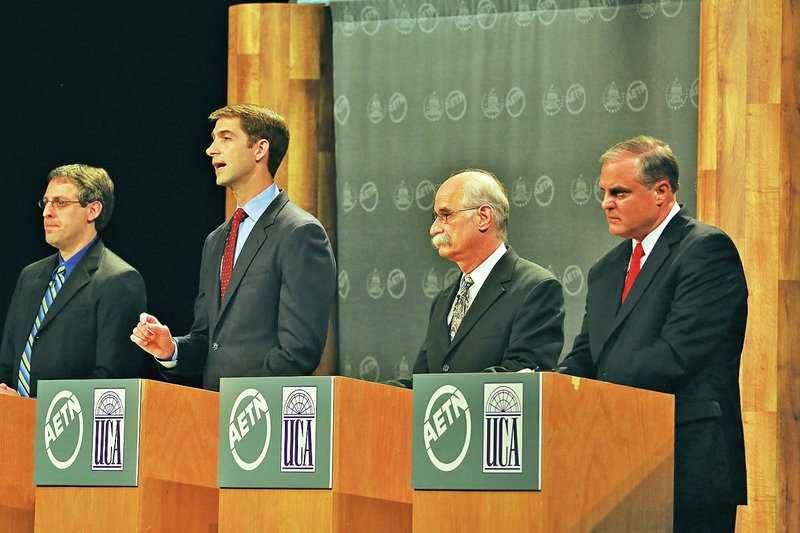Television has long been established as the playing field, the forum, the arena for our major political campaigns.
Increasingly and ridiculously these campaigns are dominated by the onslaught of 30-second political TV ads.
Yes, there are still public campaign events and political rallies such as those featuring former President Clinton as he made a barnstorming tour of Arkansas seeking to generate support for Democratic candidates.
And there are still some campaign visits to traditional stops: fairs, parades, local festivals.
Along the way, candidates vie with each other to get "unpaid media" coverage on TV, hoping to generate a sound bite that will make the news.
However, as campaigning has evolved, there is an additional factor that can provide voters with a chance to get a close-up look at candidates, a look that is neither a packaged TV spot or an attack ad (often distorting the facts) aimed at a candidate by the opposition.
Televised debates have become a fixture of American politics. The current election cycle has brought many political aspirants before the cameras, including two debates involving Mark Pryor and Tom Cotton, candidates in the U.S. Senate race which is being closely watched nationally.
If voters in Arkansas have not become totally cynical and desensitized by the TV ad wars, on which up to $30 million may be spent, they have had the opportunity to view how the candidates handle themselves and respond to questions in two recent televised debates.
Debates haven't always been part of the political process. They really began with the coming of television, and despite the historic renown of the 1960 Kennedy-Nixon "great debates" it took a while for them to catch on. It was not until 1976 (Ford vs. Carter) that we had more presidential debates and they have continued every four years since. Moreover, debates among party contenders and candidates for congressional and state offices have also become regular features of campaign seasons.
Those first Kennedy-Nixon confrontations foreshadowed the enormous role that TV would play in our politics, including a heightened emphasis on style and appearance.
Even that first, by now almost mythical debate, resulted in media pundits and analysts declaring winners and losers. And the response to that initial debate proved to be highly instructive and prophetic. Particularly significant was the difference between radio and television. A poll taken soon afterward indicated that Kennedy "won" among those who saw the debate but Nixon had a slight advantage among those who only listened.
Earl Mazo, a leading political journalist at the time, recalled that he was in Hot Springs, covering the Southern Governors' Conference. For whatever reason, the telecast of the first debate was seen there on a delayed basis, so many of the governors and reporters first heard the debate, then saw it. Their reaction, he said, pointed up the difference between hearing and seeing. Before the encounter on radio was half finished every Kennedy partisan "was disparaging the whole idea of a fine, upstanding young man like Kennedy having to clash verbally with a crusty old professional debater" like Nixon. But, Mazo said, "the attitude changed immediately when the magic lantern of television came on."
Kennedy had a natural affinity for communicating through TV, while Nixon looked haggard and less at ease.
Today the compulsion to declare winners and losers continues. The candidates usually try to work in memorable phrases, sharp quips and one liners, or to put their opponents on the defensive. Frequently, we see a repetition of talking points that they are determined to drive home. And candidates frequently go into a defensive posture, carefully guarding against gaffes that can prove costly. The result is that some of the debaters appear almost robotic.
In the Pryor-Cotton debates, the casual viewer might have become confused about who was debating whom. Cotton, it seemed, was actually debating Barack Obama, while Pryor was intent on connecting Cotton to his "out-of-state billionaire backers."
Sometime the candidates fail to answer questions from the panelists, even when repeatedly asked to do so. And the restrictions on follow-up questions, which sometimes are agreed to in the preliminary debates about the debates, are regrettable.
Despite their shortcomings and limitations, however, the debates can be valuable to the voting public, providing a view of the candidates not completely obscured by the advertising blitz. And in Arkansas AETN presents debates for all the statewide and congressional offices, a very important service -- particularly in a year when many of the races have been overshadowed by the Senate campaign.
Those first televised debates back in 1960 introduced an important new dimension to American political campaigning. It has become a tradition worth continuing.
HOYT PURVIS IS A JOURNALISM AND INTERNATIONAL RELATIONS PROFESSOR.
Commentary on 10/19/2014
